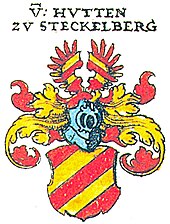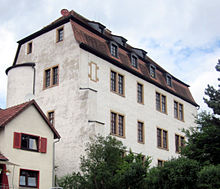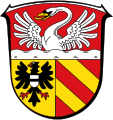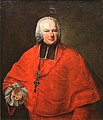Hutten (noble family)
The family of Hutten is an old to nobility belonging Franconian noble family . The name probably goes back to the village of the same name in the Altkreis Schlüchtern ( Main-Kinzig-Kreis , Hesse ). It is derived from the Old High German word huota ("the hat" / huot ) and describes the herding of cattle, or the hut pasture ( huotwad ).
Origins
The Lords of Hutten, together with the Lords of Thüngen, were among the most important noble families in the northern Spessart . In a document from 1140 a Hecekind is mentioned, not named by his surname, who bequeathed a property in the village of Hutten, which he owns according to inheritance law, to the Fulda monastery for his soul memory ; this is to be assumed as the earliest ancestor of the family. The oldest reliable testimony to the family comes from the year 1274 , in which the brothers Erkenbert, Hermann and Johann de Huten appeared as witnesses in a document from the Schlüchtern monastery . Earlier mentions, which are said to go back to the 10th century, are legendary expressions of the family tradition, but historically not sufficiently documented. The origin of the ministerial office in Fulda is likely to be certain .
Important personalities such as the humanist Ulrich von Hutten , as well as several bishops and a cardinal emerged from the von Hutten family .
Lines
The main trunk of the von Hutten family was divided into four lines from the 14th century, each with further branches. The family lines used the names of their possessions or castle seats as an additional name attribute. Branches of the family still exist today.
Hutten-Franken line
- Hutten-Unterhutten († 1541)
- Hutten-Oberhutten
- Hutten-Frankenberg († 1556)
- Hutten- Birkenfeld († 1783)
The Franconian line of the von Hutten family was initially active in Arnstein for over two centuries and provided the officials there after the Würzburg Prince-Bishop Albrecht II von Hohenlohe pledged the castle and the Arnstein office to the brothers Conrad and Frowin. In 1489, Bishop Rudolf II von Scherenberg redeemed the debt and received the pledge back. The tribe of the Hutten Franconians split up under Conrad's grandchildren into the branches of Ober- and Unterhutten. The Oberhutten left Arnstein in the first half of the 16th century and formed new lines under Ludwig at Schloss Frankenberg and under Konrad at Schloss Birkenfeld .
Frankenberg Castle (Steigerwald)
As part of the Imperial Knighthood, the Hutten Franconians organized themselves in the Franconian Knight Circle and belonged to the knight cantons of Baunach , Odenwald , Rhön-Werra and Steigerwald .
Hutten-Gronau line
- Line Sebastian († 1704)
- Line Alexander († 1627)
The fate of Altengronau was largely determined by the lords of Hutten zu Gronau from around 1300 to 1648 . Together with the Altengronau court , these formed a separate judicial district that also extended to numerous neighboring towns. Ludwig von Hutten, who is mentioned in a document issued on June 21, 1300 , is considered the progenitor of the von Hutten zu Gronau family . It is assumed that Ludwig lived in "the old house" - the first castle complex in Altengronau, for whose existence there are no archaeological findings, but whose location is assumed to be in the forest on the Frauenberg. The four castles built by Hutten in Altengronau, two of which ( Huttenburg and moated castle ) have been preserved to this day.
In 1648 , the possessions of the Lords von Hutten zu Gronau , which had been destroyed in the Thirty Years' War , were sold by Philipp Daniel von Hutten to Amalie Elisabeth von Hanau-Münzenberg , Landgrave of Hessen-Kassel - subject to his continued membership in the imperial register. This ended the rule of the Lords of Hutten in Altengronau, which had lasted since the 13th century.
The main line of the Lords von Hutten zu Gronau died out with the death of Johann Hartmann on January 17, 1704 in Sannerz .
Hutten-Steckelberg line
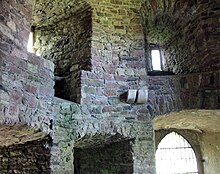
The Steckelberg line of the von Hutten family owned properties around Ramholz and Vollmerz near the town of Schlüchtern. Particularly noteworthy is the strategically important hilltop castle Steckelberg , where Ulrich von Hutten was born in 1488 .
Hutten-Stolzenberg line
- Hutten-Stolzenberg-Hausen († 1529)
- Hutten-Salmünster († 1800)
- Hutten-Soden († 1646)
- Hutten-Romsthal-Steinbach (this line still exists today in Steinbach (Lohr am Main) and at Altengronau Castle)
The Hutten-Stolzenberg line had possessions, castles and palaces around what is now Bad Soden-Salmünster . The sex played a decisive role as the protective power for the salt production operated in the region (see also Huttengrund ).
Frowin von Hutten, who was killed in a feud with Ulrich IV von Hanau zu Steinau an der Straße in the spring of 1373, is considered the founder of the tribe . Frowin's three sons ensured the continuation of the line, which later branched into the sub-lines Hausen, Salmünster, Soden and Romsthal-Steinbach.
The Hutten-Stolzenberg residences were Stolzenberg Castle from 1299 to 1536, when the Huttenschloss Bad Soden was built as a new residence (owned by the family until 1819), Hausen Castle (Bad Soden) (1345-1540), the Schleifrashof (up to 1540) as well as the baroque Steinbach Castle in Lohr am Main, which was rebuilt in 1725 on an estate that has been family-owned since 1625 until today.
Family burials
The following should be mentioned at the burial of the Knights of Hutten:
- Ascension Church Altengronau
- Parish and pilgrimage church Maria Sondheim near Arnstein
- Parish church of St. Josef in Lohr-Steinbach
- Salmünster Collegiate Church
- Schluechtern Monastery
- Church in Reusch (Weigenheim)
- Himmelspforten Monastery in Würzburg
- Schönborn Chapel at the Würzburg Cathedral
- Holy Cross Church in Oberlauringen
coat of arms
The coat of arms of those von Hutten shows two golden diagonal bars on a red background. The crest differs for the different lines. The coats of arms at Siebmacher show a flight or a red-clad man's fuselage. The figure wears a beard and a red pointed hat with a silver tip, which is decorated with three black cock feathers at the top and on both sides of the tip.
The coats of arms of the bishops are usually increased , the basic motif of the bars is repeated alternately in two of the four fields.
Coats of arms variant after Adolf Matthias Hildebrandt
Elements of the coat of arms of those von Hutten in the coat of arms of the Hessian district Main-Kinzig-Kreis
Coat of arms of Prince-Bishop Moritz von Hutten on the Hohenrechberg epitaph
Coat of arms of Prince-Bishop Franz Christoph von Hutten
Coat of arms of Prince-Bishop Christoph Franz von Hutten at the entrance to the Zehntkeller in Iphofen
The Hutten-Czapski
→ Main article: Hutten-Czapski
The Polish aristocratic family of the Czapski , which at times referred to a legendary descent from the von Hutten, has no demonstrable agnatic connection.
Personalities
- Friedrich von Hutten (named from 1328, † 1363), governor in the Wetterau and Reichsschultheiß of Frankfurt am Main
- Hans von Hutten (1477–1515), Württemberg stable master of Duke Ulrich von Württemberg
- Ulrich von Hutten zu Steckelberg (1488–1523), humanist , is also known as the first imperial knight
- Moritz von Hutten (1503–1552), Prince-Bishop of the Hochstift / Fürstbistum Eichstätt , see also Moritzbrunn
- Philipp von Hutten (1505–1546), conquistador in Venezuela (in the service of the Welser )
- Christoph Franz von Hutten (1673–1729), Prince-Bishop of Würzburg (1724–1729)
- Philipp Wilhelm von Hutten zum Stolzenberg (1701–1757), canon
- Franz Christoph von Hutten zum Stolzenberg (1706–1770), Prince-Bishop of Speyer and Prince Provost of Weißenburg (1743–1770), see also Huttenheim
- Ferdinand von Hutten (1793–1857), Royal Bavarian Rittmeister and member of the Hessian Estates Assembly
Hans von Hutten (1477–1515), stable master from Württemberg
Moritz von Hutten (1503–1552), Prince-Bishop of Eichstätt
Philipp von Hutten (1505–1546), conquistador
Christoph Franz von Hutten (1673–1729), Prince-Bishop of Würzburg
Franz Christoph von Hutten zum Stolzenberg (1706–1770), Prince-Bishop of Speyer
Individual evidence
- ^ Georg-Wilhelm Hanna: Ministeriality, power and mediatization. The knight nobles von Hutten, their social position in church and state until the end of the Old Kingdom = Hanauer Geschichtsblätter 44. Hanau, 2007. ISBN 3-935395-08-6 = Diss. Bamberg 2006, page 27 on the OPUS server , PDF 7,024 kB
- ↑ See also the origin of the word "hat"
- ^ Ernst Friedrich Johann Dronke (Ed.): Codex diplomaticus Fuldensis , Verlag Theodor Fischer, Kassel 1850, page 389, no.793
- ↑ Wenck, Hess. Landesgeschichte II, document p. 207
- ↑ Hoffmann, Hermann (arrangement): The oldest fief book of the Würzburg Monastery 1303-1345 , Würzburg 1972, No. 375
- ↑ Ledderhose, Konrad Wilhelm: Contributions to the description of the church state of the Hessen-Casselischen Lande , Kassel 1780, page 468
- ^ Genealogy of the Knights of Hutten - Parish Church of St. Josef in Lohr-Steinbach
literature
- Genealogical manual of the nobility , Adelslexikon Volume V, Volume 84 of the complete series, page 343, CA Starke Verlag, Limburg (Lahn) 1984, ISSN 0435-2408
- Georg-Wilhelm Hanna: Ministeriality, Power and Mediatization. The knight nobles von Hutten, their social position in church and state until the end of the Old Empire = Hanauer Geschichtsblätter 44. Hanau, 2007. ISBN 3-935395-08-6 = Diss. Bamberg 2006 on the OPUS server , PDF 7,024 kB.
See also
- List of Frankish knight families
- Hutten's Last Days - poem from 1870

